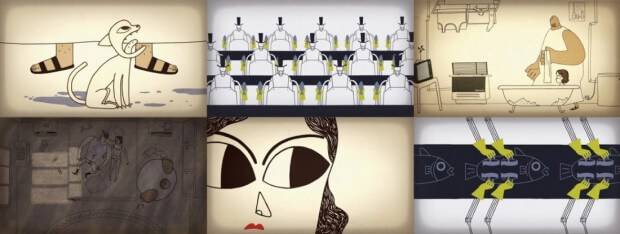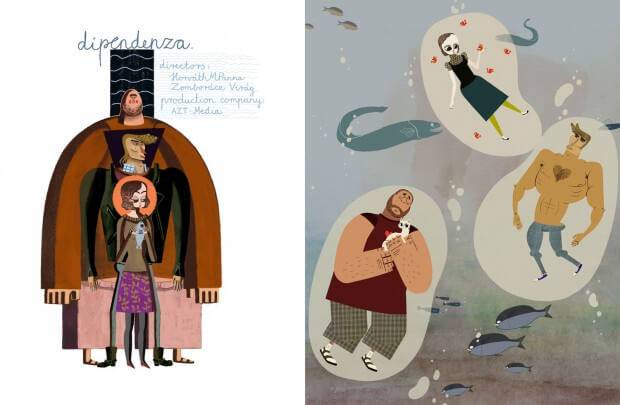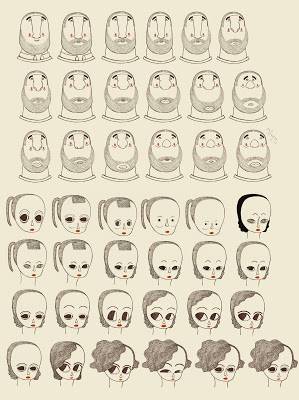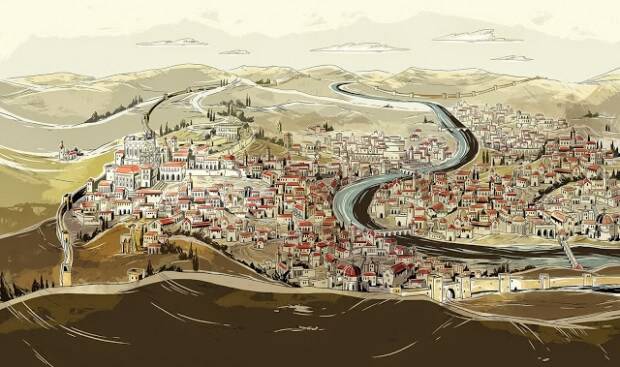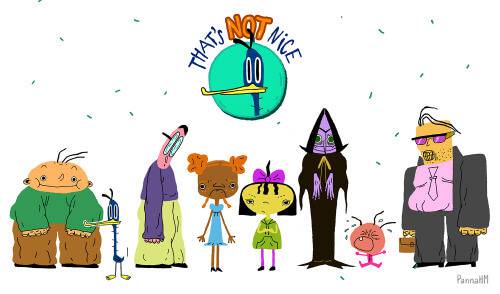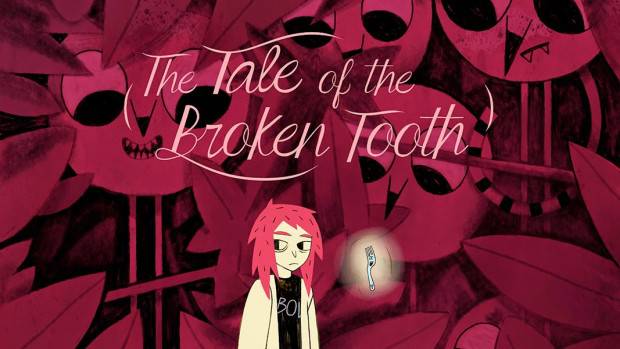Interview with ‘Dipendenza’ Co-Director Panna Horvath-Molnar
Earlier this year saw the online release of Panna Horvath-Molnar‘s graduation film Dipendenza after a significant stint on the festival scene. The stylish short film tells the unusual story of lovestruck Bubu as he attempts to keep ahold of the affections of Anglea, the ever-elusive object of his desire. Co-directed by Virág Zomborácz who also wrote the original story, this bizarre tale of tortured love combines with Panna’s brilliant design work to make a comical film that has enjoyed screenings across the globe.
Since graduating from MOME and touring with the film, Panna has been freelancing on a combination of commissions as well as other short film ideas, all of which retain her unmistakable ability to design for story in unique and highly inventive ways. It is this eye for design and effortless storytelling ability that has seen her join forces with Bristol based studio Rumpus. We chatted to Panna about design, her films and the future.
Dipendenza has recently been released online, having enjoyed a very long and successful film festival run. How did you find the response to the film from both your peers and the audience?
I was really happy to get into all the festivals, but it meant even more to be approached by various people personally and be told they liked my film. Those were definitely the best moments, although I had to learn that the predefined positioning of your film (which section, under what theme etc) matters a lot. Having a long film like Dipendenza with quite subtle gags did not always work within its section. There were festivals where a lot of people reacted and laughed, at other times complete silence followed.
The film was created at MOME where you studied, could you tell us about the school and what it was like to work there?
During my years at uni the animation course went through a lot of positive and drastic changes, thanks to József Fülöp, who became head of the department around the same time my application was accepted. I think the school’s greatest strength is coming from supporting each person’s individual style, together with attempts to make the students try a lot of different animating techniques; you will try everything from puppet animation to 2D and digital 3D. The side effect of this structure is that you have to deepen your skills on your own if you want to gain professional knowledge in one specific area. I also learned a lot from my classmates and we formed really close friendships, the atmosphere was awesome.
The story – a wicked love triangle that circles around the lovely, if not a little misunderstood, Bubu – was written by your co- director Virág Zomborácz, did she approach you with the story or did you always plan to work on this together?
Originally I wanted to make something together with my classmates for graduation, but it didn’t work out. Then Virág, who works as a live action director and script writer, approached me with a script of hers saying she thought this could work as an animated film, too, and in case I like it, we could work on it together. I read it and immediately felt what she was talking about – the script had characteristics already which reminded me of my cherished Estonian animation. It was an easy decision.
Were you entirely responsible for the development of how the characters should look?
Yes, Virág gave me a free hand in basically everything related to animation, including the style. During the work I showed her the partial results from time to time. She was a very good partner, we were on the same side and agreed on almost everything.
Your style is so emotive and wonderful, it has a very Dutch/Nordic minimalistic feel to it that I and many others really enjoy, can you explain how it was developed and who in the world of art has inspired you most?
As mentioned before, the script written by Virág already gave off that Nordic/Estonian vibe. During that time I was really inspired by Kaspar Jancis’ Crocodile and Priit Parn‘s short films so it was easy to decide on which direction the film should take. We worked almost a year on the storyboards and animatic, it was my first time making a film this long and a story this complicated, I really wanted to nail it as much as I could. I learned a lot from the process of how to change a live-action script into animation. I also remember watching Life Without Gabriella Ferri repeatedly: it was a really good example of how to make every single movement made by a character into a small gag especially defining him or her. Overall, however, I am mostly influenced by comic books, especially manga and European graphic novels.
Since leaving MOME and finishing Dipendenza you have gone on to work on many other exciting projects and had a lot of experience as a background artist. Can you tell us about the projects you’ve worked on such as Luther and Mese and what it is about working on backgrounds you particularly enjoy?
Fortunately the Hungarian animation industry started to come to life again in recent years after a long stagnant period, partly thanks to MOME’s great animation course and some newly available funding, so there are more and more good new projects coming to life, and we have lots of work to do. I have just designed the complete look of a newly funded series for preschool children, directed by Bella Szederkényi and produced by their studio CUB. The series is about independent tales of kings and their strange hobbies. I’m working on the Luther series directed by Zsolt Richly as a color and background artist since graduation. It’s about the life of Martin Luther and is being made for the 500th anniversary of the protestant religion. I also often helped in other MOME students’ graduation films as a background artist, like Attila Bertóti’s Mese, which is currently touring in festivals. As for what I enjoy about working on backgrounds – I think it comes from the simple fact that I love drawing really detailed pictures. I used to make digital paintings which often took me two or three weeks, I was never bored.
You also created two short children’s films called Majom and Ki Szelet Vet, can you tell us about these stories and their origins and what prompted you to make them?
Majom (Monkey) and Ki Szelet Vet (He Who Raises Wind) are part of a small series consisting of individual short films produced by MOME. They are all based on contemporary children’s poems and are around two minutes long. MOME started this project when I was still studying there. Since then I took part in three series and soon I will start working on two new shorts called Rose on the Moon and Purple Gorilla. It’s not easy to make your own film, get funding etc, so this is a great opportunity for all of us who participate to make something of our own. I always liked making these, they are short, easy and fun, almost no stress involved.
You’ve also started working on a project in a collective for a series called That’s Not Nice which centers around a duck, what’s the premise of the series?
TNT will be a seriously funny cross-media meme with a social purpose: to give tweens a tool to handle being teased or bullied. The center of the series’ absurd humor is The Duck, whose character comes from the irrational fear of being watched by a duck, called ‘Anatidaephobia’ .
What’s your role in the project and whereabouts in production are you now?
I’m in charge of design mainly, but if we manage to fund it then I might help in storyboards and layout, too. We are in need of a really good writer too, finding one is top priority to be able to take one step further in pre-production.
Your next short film is called The Case of the Broken Tooth, are you able to talk about the story or the characters at this stage?
The Case of the Broken Tooth will be a funny fantasy adventure. The story centers around Polly, a grumpy girl, who hates her life and never smiles. She experiences something quite unusual: when she trips and breaks her front teeth, a small piece of tooth comes to life in front of her very eyes, and pulls her into another world. Chasing after the runaway Mr. Tooth leads her through many funny and bizarre worlds, where she also meets a quite annoying ally: The Phenomenal Pfork of Fate, a talkative magic fork, who makes the worst jokes ever. I am not willing to tell you more than this right now!:)
Can you explain to our readers what the Animation Sans Frontieres programme is/does and how you’ve found the experience?
Sure! Animation Sans Frontieres, or ASF for short, is an international animation production workshop for young animation professionals, who are just starting their carreer and fresh out of school. The programme is a collaboration between well-known animation schools: the Dutch Animation Workshop, the French Gobelins, the German Filmakademie Baden-Württemberg and lastly the Hungarian MOME. You spend two weeks in every school, and take part in a lot of lectures which take you through the process of making an animated film while you also develop your own project. Participating in ASF was one of the most cherished part of my life so far. I met so many great friends there, who are also awesome professionals, and visited various European countries. I highly recommend it!
As well as all this you have also joined Bristol based studio Rumpus as a director, how did your involvement with them come about?
Rumpus’s Seb Burnett is also a friend from ASF, he is a really kind and funny guy who supports me a lot, and I am extremely grateful to him. He was the one who invited me to join Rumpus. Since then we worked together on a few projects with Joe Wood as well, he’s an awesome chap, too. Hopefully there will be even more coming!
Your work over all of these projects is so different but still undeniably your own, how do you tackle the challenge of adapting your work for different projects and clients?
Every film and story requires a style specially developed to suit them, and I always loved trying out and drawing in new styles: it’s exciting and great to develop your skills. Although sometimes it can be frustrating too, as we all have limits, and it’s easy to run into things which don’t turn out so well. However I think I won’t be satisfied with working with the same style most of the time, although I have to admit I don’t consider myself to have a very specific style of my own, and I often really envy people with distinctive styles.
What are you looking forward to next in your working life?
Since I graduated I did mostly commissioned works, and now I wish nothing more than a bit of free time to simply draw just for myself. For years I have only been drawing digitally, now I would like to make something manually again, too.
Keep up to date with the work of Panna Horvath-Molnar at pannahm.blogspot.co.uk and pannanim.tumblr.com


